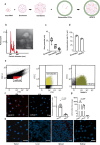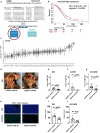Enhanced plant-derived vesicles for nucleotide delivery for cancer therapy
- PMID: 38582949
- PMCID: PMC10998889
- DOI: 10.1038/s41698-024-00556-3
Enhanced plant-derived vesicles for nucleotide delivery for cancer therapy
Abstract
Small RNAs (microRNAs [miRNAs] or small interfering RNAs [siRNAs]) are effective tools for cancer therapy, but many of the existing carriers for their delivery are limited by low bioavailability, insufficient loading, impaired transport across biological barriers, and low delivery into the tumor microenvironment. Extracellular vesicle (EV)-based communication in mammalian and plant systems is important for many physiological and pathological processes, and EVs show promise as carriers for RNA interference molecules. However, some fundamental issues limit their use, such as insufficient cargo loading and low potential for scaling production. Plant-derived vesicles (PDVs) are membrane-coated vesicles released in the apoplastic fluid of plants that contain biomolecules that play a role in several biological mechanisms. Here, we developed an alternative approach to deliver miRNA for cancer therapy using PDVs. We isolated vesicles from watermelon and formulated a hybrid, exosomal, polymeric system in which PDVs were combined with a dendrimer bound to miRNA146 mimic. Third generation PAMAM was chosen due to its high branching structure and versatility for loading molecules of interest. We performed several in vivo experiments to demonstrate the therapeutic efficacy of our compound and explored in vitro biological mechanisms underlying the anti-tumor effects of miRNA146, which are mostly related to its anti-angiogenic activity.
© 2024. The Author(s).
Conflict of interest statement
S.C., Y.L., E.B., E.S., N.N.B., A.L.A., S.N., C.R.A., H.C., Y.W., L.Z., S.L., and G.L.B. declare that they have no competing interests. These authors declare the following competing interests: H.L. is a shareholder and scientific advisor of Precision Scientific Ltd. A.K.S. declares the following competing financial or non-financial interests: he is a shareholder of BioPath and a consultant for Merck, AstraZeneca, Onxeo, ImmunoGen, Ivlon, GSK, and Kiyatec.
Figures




References
Grants and funding
LinkOut - more resources
Full Text Sources

